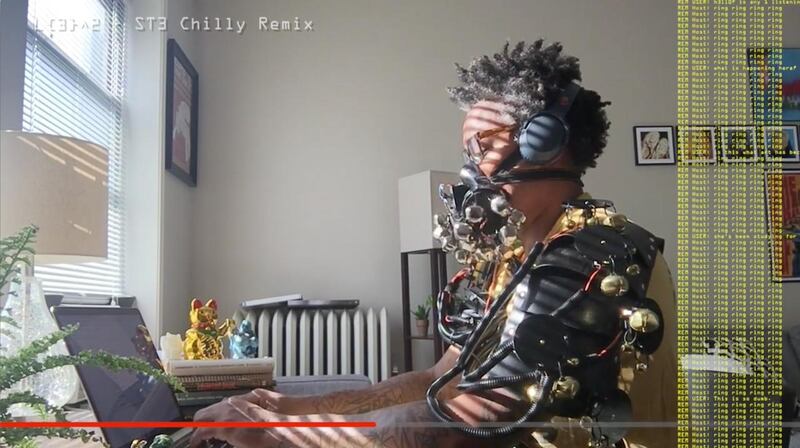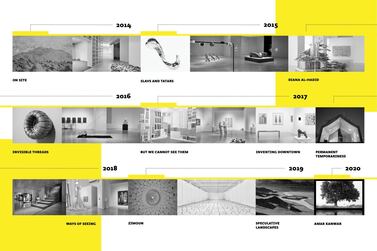Despite the weariness around Zoom meetings and virtual events that has developed this year, our smartphones remain portals to distraction and entertainment.
“The smartphone persists as a site of diversion, escape and the meaningful pleasure of discovery,” curator Maya Allison points out.
Allison is the executive director of the New York University Abu Dhabi (NYUAD) Art Gallery and the university's chief curator. Alongside artist and NYUAD assistant professor Heather Dewey-Hagborg, she has put together the gallery's first virtual exhibition, tailored entirely for the smartphone screen.
The exhibit – not in, of, along, or relating to a line – opens on Wednesday, January 20 and features nine artists who primarily deal with technology in their works: Cao Fei, Sophia Al Maria, Zach Blas, Addie Wagenknecht, Eva and Franco Mattes, Lee Blalock, Maryam Al Hamra, Micha Cardenas, and the trio of Ramin Haerizadeh, Rokni Haerizadeh and Hesam Rahmanian.
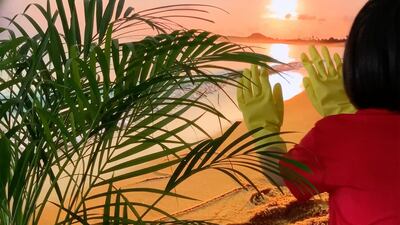
All the works in the show are “born digital”, as the gallery puts it, a concept explained by Dewey-Hagborg as “always originally making use of digital technology as a medium".
“This distinguishes it from work that accidentally ends up online as documentation, for example," she says. "We think this makes for a particularly strong online exhibit because it isn’t trying to force work that is meant to be viewed in person, like sculpture, on to a digital distribution platform. Rather, the online platform amplifies the already digital nature of the work.”
As the title suggests, the exhibition takes no direct path. Visitors can weave from one artwork to another, designed to “embody the branching and decentralised paths originally envisioned as the internet", Dewey-Hagborg says.
“We told the artists we were designing an exhibition that was natively online and, even further, meant to be viewed from a mobile phone, held in the palm of your hand."
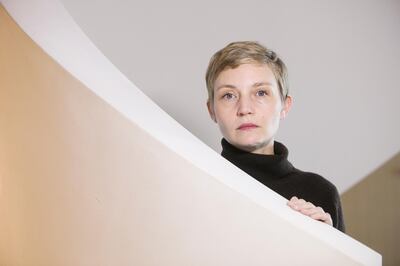
Thematically, not in, of, along, or relating to a line is built around Dewey-Hagborg’s discussions about digital technology’s effect on our sense of identity, and how the pandemic has brought about its own impact on our sense of self and the artists’ practices.
It casts neither censure nor commendations on tech, but rather a “deep ambivalence” towards it, as Dewey-Hagborg describes. “These artists are on one level enamoured with technology … but on another level they are often deeply troubled by the power structures it embodies and the political impact it continues to have in our daily lives,” she says.
Works in the exhibition include American artist Wagenknecht's Opsec and Beauty series. Modelled after popular "beauty hacks" on YouTube, the cosmetic tutorials are cybersecurity lessons in disguise – a 2018 video, for example, is named "korean sheet masks and password management for pore refining wins".
“By teaching methods of cybersecurity in an accessible and quite humorous way, Wagenknecht dismantles the patriarchal and alienating status quo in information security,” Dewey-Hagborg explains. Wagenknecht has created a new work of contemporary still lifes for NYUAD Art Gallery.
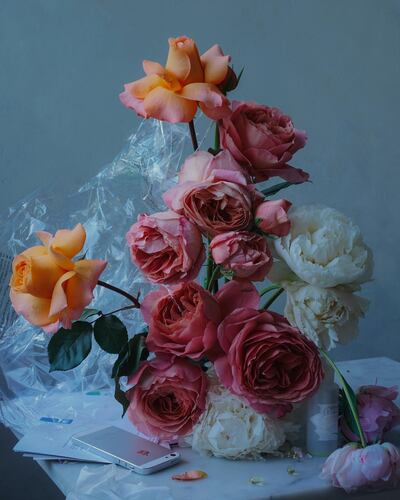
Arab artist Al Maria will premiere a generative poem developed by an AI bot that was trained on her own writing, while Blalock has crafted a narrative around a cyborg, giving it a home life where it performs mundane chores.
To take a typically public event such as an art exhibition and modify it specifically to live on the smartphone screen proffers a kind of intimacy between the viewer and the artwork.
After all, is there any object more intimate and more private to us than our smartphones? These pocket-sized computers contain our contacts, photographs and messages, as well as the apps that allow us to connect to the world and to run our daily lives.
Amid the dozens of streams and feeds powered by algorithms which seem to know us all too well, is there space for art? Allison thinks so. “The art world may or may not have algorithms … but art has a 73,000-year track record, with mark-making and human expression through images, symbols and storytelling,” she says.

With this virtual show, Allison claims the gallery is setting its own test on the appeal of art on the screen. “So much digitally created art lives more comfortably on your phone than in a gallery,” she says.
Allison highlights the work of artists Haerizadeh, Haerizadeh and Rahmanian titled From March to April... 2020, an almost video diary made during lockdown documenting overhead shots of their table that was crowded with paint, drawings, food and newspapers.
The artists had sent the work out to their contacts, Allison included. “For the first time in the pandemic, I had what felt like a genuine encounter with an artwork,” she recalls. “It was clear to me when I saw that video that this was not social media. This was not an algorithm. This was genuine, a unique and specific expression.”
She describes it as a light bulb moment, recognising that art in the digital sphere can be as stirring as that in the physical realm. In the present day, when the art world’s commercial survival and relevance seems to hinge on its virtual presence, perhaps online art is the way forward, picking up where net art left off in the 1990s.
“Phones are already extensions of our bodies into the virtual world, and they are still a place we turn to for warmth and cheer, for discovery and meaning,” says Allison.
“Those are the same words I would use for what the best museums and galleries can be: places where we can enter a different frame of mind, to connect with our humanity, and to view the world around us – or in our hand – differently.”
The exhibition not in, of, along, or relating to a line opens on Wednesday, January 20. For more details, visit nyuad-artgallery.org
